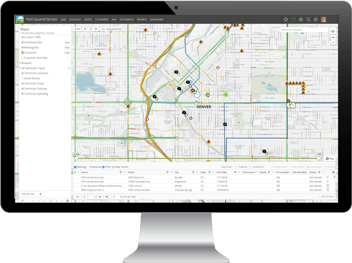
Increasing operational efficiency is the number one reason field service organizations make the switch from paper-based processes to mobile field service management software. No organization or industry is immune to lost productivity, but in field service, efficiency is everything. Every wasted minute affects scheduling, costs, and customer satisfaction.
Every day, inspections take place, plant rounds are completed, and fiber cables are installed. Yet, assets get misplaced, addresses go missing, and customers are left wondering when a technician will arrive. These are daily productivity drains that add up quickly. The good news is that each one has a solution. Here are five proven ways to avoid losing time in the field and boost your team’s productivity.
1. Employ Route Optimization Tools
Dispatchers and field operations managers spend their days juggling changing schedules, rerouting technicians, and trying to minimize delays. When a technician is out sick or a job runs long, one change can ripple across multiple work orders.
Modern route optimization software makes this challenge manageable. By analyzing real-time locations, job priorities, and vehicle capacities, it creates optimized routes that reduce fuel costs, shorten travel time, and increase the number of completed jobs per day.
Integrated mapping and mobile app navigation ensure technicians can find every job site without guesswork. With geocoded addresses and embedded driving directions, technicians spend less time navigating and more time completing work.
2. Know Where Your Assets Are at All Times
Enterprise asset management is one of the most effective ways to improve field efficiency, and yet, it is often overlooked. Real-time asset tracking gives field technicians and managers instant visibility into where tools, equipment, and vehicles are located.
Knowing exactly where your assets are helps technicians start work faster and eliminates time wasted searching for misplaced equipment. Over time, location data also reveals usage patterns that can improve asset placement, reduce downtime, and guide technician training.
When evaluating field service management software, make sure it includes strong asset tracking and management features. This capability alone can significantly reduce inefficiency across teams and job sites.
3. Communicate in Real Time with Customers
Customer communication can make or break a field service business. Missed updates or unclear arrival times lead to frustration and lost trust.
Embedding real-time communication into your workflow changes that. Using SMS, chat, or email notifications, you can automatically alert customers when a technician is en route, delayed, or when a job is rescheduled.
These updates not only improve transparency but also reduce inbound support calls, helping teams focus on the work that matters. In many industries, proactive communication has become a competitive advantage and one that customers now expect.
4. Enable Your Technicians with Mobile Field Service Solutions
Handing your technicians a tablet or smartphone is only the beginning. The real value comes from giving them a complete mobile field service solution that allows them to finish the entire work order while in the field.
Look for functionality that supports field data capture, such as photo uploads, barcode scanning, and the ability to annotate or markup images. With access to job documentation, procedures, and service history, technicians can make faster, more accurate decisions without calling the office.
When mobile workflows include built-in checklists and contextual guides, repeat visits are reduced, and technicians can deliver a higher first-time fix rate, one of the biggest drivers of customer satisfaction and ROI.
5. Eliminate Manual and Duplicate Data Entry
Manual processes remain one of the biggest time wasters in field service operations. Reusing the same work order templates without automation often leads to repetitive data entry and errors.
Digitizing forms allows you to add conditional logic, auto-filled fields, and rule-based workflows, saving hours of administrative time. The biggest efficiency gains come when your field service platform integrates seamlessly with back-office systems so updates made in the field automatically sync with billing, ERP, or CRM data.
Modern platforms should support API or SFTP integrations that keep every system aligned. No more logging into multiple tools to update the same information. Automation reduces human error, increases visibility, and frees your teams to focus on higher-value work.
The Bottom Line
Field service work is fast paced, complex, and time sensitive, but that is exactly why automation matters. By combining optimized routing, mobile tools, real-time communication, and integrated asset management, field teams can spend less time chasing information and more time delivering value to customers.


